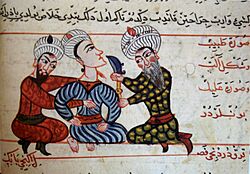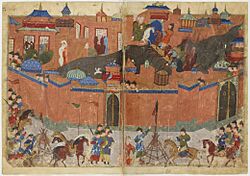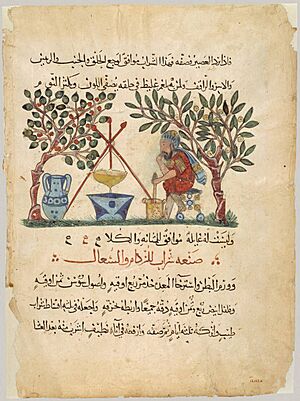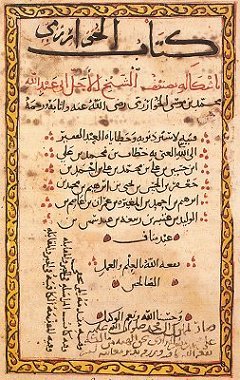House of Wisdom facts for kids
Quick facts for kids House of Wisdom |
|
|---|---|
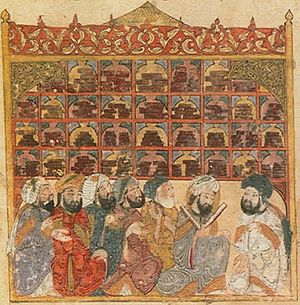 |
|
| Scholars at the Abbasid library (Maqamat al-Hariri) Illustration by Yahya ibn Mahmud al-Wasiti, 1237 |
|
| Country | Abbasid Caliphate (now Iraq) |
| Type | Library |
| Established | c. 8th century CE |
| Location | Baghdad |
The House of Wisdom (Arabic: بَيْت الْحِكْمَة Bayt al-Ḥikmah), also known as the Grand Library of Baghdad, was a famous center for learning in Baghdad. It was a major library and a place where smart people gathered during the Islamic Golden Age.
It started either as a library for Caliph Harun al-Rashid in the late 700s or as a private collection for Caliph al-Mansur. Later, during the rule of Caliph al-Ma'mun (813–833 AD), it became a public academy and a large library. Sadly, the House of Wisdom was destroyed in 1258 when the Mongols attacked Baghdad.
Contents
A Hub for Knowledge
The Great Translation Movement
The House of Wisdom was a big part of the "Translation Movement." During this time, scholars translated many important books from Greek and Syriac into Arabic. This helped spread knowledge from ancient Greece, Persia, and India.
This movement led to amazing new discoveries in the Muslim world. People started doing advanced research in math, astronomy, philosophy, and medicine. This was the start of what we call Arabic science. It also created a huge need for more and better translations of old texts.
Why Scholars Came to Baghdad
Baghdad was the capital of the Abbasid Empire. This made it a magnet for scholars from all over the Islamic world. Many famous thinkers, like al-Jahiz and al-Kindi, studied there.
They created a lively learning community. They wrote many important books and made new discoveries. The House of Wisdom was originally called Khizanat al-Hikma, meaning "Storehouse of Wisdom." It was a place to keep rare books and poems safe.
Inside, writers, translators, scientists, and scribes met every day. They would translate, write, talk, and read together. Many books on science and philosophy were translated into different languages here.
History of the House of Wisdom
How it Began
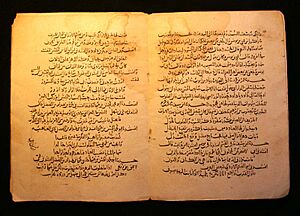
From the 4th to the 7th centuries, scholars in the Arabic languages continued the work of earlier Greek thinkers. Important learning centers included schools like Nisibis and Edessa. There was also a famous hospital and medical academy in Gondishapur.
Libraries in places like Alexandria and Constantinople also played a role. Other centers for translation and learning were in Merv, Salonika, Nishapur, and Ctesiphon.
During the Umayyad rule, Muawiyah I started collecting books in Damascus. This library was also called "Bayt al-Hikma." Muslim scholars translated books from Greek, Latin, and Persian. These books covered medicine, physics, math, and other subjects.
The Umayyads also learned how to make paper from the Chinese. They brought many old learning centers under their control. They hired Christian and Persian scholars to translate books and create new knowledge. These steps were key to the growth of learning in the Arab world.
Baghdad Becomes a Center of Learning
In 750, the Abbasid family took over from the Umayyads. In 762, Caliph al-Mansur (who ruled from 754–775) built Baghdad and made it his new capital. Baghdad was a great spot for trade and learning because of its location and diverse people.
The Abbasids were influenced by the Persian Empire. They adopted the idea of translating foreign works, but now into Arabic. Al-Mansur built a palace library like the Persian one. He also supported the scholars who worked there. He even invited scholars from India to share their knowledge of math and astronomy.
Many foreign books were translated into Arabic during the Abbasid Empire. These came from Greek, Chinese, Sanskrit, Persian, and Syriac languages. The Translation Movement grew even more under Caliph Harun al-Rashid. He loved learning and poetry.
Al-Rashid's library was the direct ancestor of the House of Wisdom. It was also called Bayt al-Hikma or Khizanat Kutub al-Hikma ("Storehouse of the Books of Wisdom"). At first, texts were mainly about medicine, math, and astronomy. But soon, philosophy and other subjects were added.
The Golden Age Under Al-Ma'mun
Caliph al-Ma'mun (who ruled from 813–833) greatly increased support for the House of Wisdom. He loved science so much that he preferred scientific texts over war treasures. People in Abbasid society also valued knowledge highly.
Scholars and translators could earn a good living. An academic life meant high status. Books were sometimes more valuable than riches. For example, al-Ma'mun demanded Ptolemy's Almagest as a condition for peace after a war.
The House of Wisdom was more than just a school. Its experts worked as engineers and architects on big building projects. They also kept accurate calendars and served the public. Many were also doctors and advisors.
Al-Ma'mun was very involved in the House of Wisdom. He visited scholars often and asked about their work. He also joined and settled academic debates. It's said he was inspired by a dream where he met Aristotle.
Al-Ma'mun often brought groups of wise people from the House of Wisdom together. They worked on big research projects to answer his questions. For example, he ordered the mapping of the world. He also had them check data from the Almagest and figure out the Earth's true size. He even helped with excavations at the pyramids of Giza.
Al-Ma'mun built the first astronomical observatories in Baghdad. He was the first ruler to fund and watch over major research projects with teams of scholars. In this way, he supported "big science" for the first time.

Like earlier rulers, al-Ma'mun sent scholars from the House of Wisdom to collect texts from other lands. One director of the House was sent to Constantinople for this purpose. Sahl ibn Harun, a Persian poet, was the chief librarian.
Hunayn ibn Ishaq (809–873), a Christian doctor, was the most active translator. He translated 116 works into Arabic. As "Sheikh of the translators," he led all translation work. He translated all Greek medical books, including famous ones by Galen and Hippocrates.
Thābit ibn Qurra (826–901) also translated important works by Apollonius, Archimedes, Euclid, and Ptolemy. Translations from this time were much better than earlier ones. This was because the new Abbasid science needed very accurate translations. New ideas were often added to the ancient works.
By the late 800s, al-Ma'mun's Bayt al-Hikma was the largest collection of books in the world. It became a major center of learning during the Medieval era. It attracted the brightest Arab and Persian minds. Knowledge was passed directly from teacher to student. Later, schools called Maktabs started to appear. In the 11th century, Nizam al-Mulk founded the Al-Nizamiyya of Baghdad, one of the first higher education schools in Iraq.
Decline and Destruction
The House of Wisdom continued to do well under al-Ma'mun's successors, al-Mu'tasim and al-Wathiq. However, it declined a lot during the rule of al-Mutawakkil (847–861). While earlier caliphs supported science, al-Mutawakkil preferred a more strict view of religion. He was not interested in science and saw Greek philosophy as against Islam.
On February 13, 1258, the Mongol army entered Baghdad. They spent a week looting and destroying the city. The House of Wisdom, along with all other libraries in Baghdad, was destroyed by Hulagu's army during the Siege of Baghdad.
It is said that so many books were thrown into the Tigris River that the river turned black from the ink. Some accounts even say the books formed a bridge across the river. Many books were also ripped apart by looters to use their leather covers for sandals. Luckily, Nasir al-Din al-Tusi saved about 400,000 manuscripts. He took them to Maragheh before the siege.
Key Activities and Discoveries
The House of Wisdom was home to scientists and scholars. It had a translation department and a huge library. This library kept all the knowledge the Abbasids had gathered over centuries. Research into alchemy, which helped form modern chemistry, also happened here. It was also linked to important astronomical observations and experiments.
Caliph al-Ma'mun encouraged the copying of Greek philosophical and scientific works. He also brought important manuscripts from Byzantium to the library. The House of Wisdom was much more than just a library. Scholars produced a lot of original scientific and philosophical work there. This helped Muslim scholars check and improve old astronomical information.
Translations from Around the World
The Translation Movement lasted for two centuries. It greatly helped science grow during the golden age of Arabic science. Ideas from Greece, India, and Persia were translated into Arabic. This led to new progress in the Islamic Empire. A main goal was to create a huge library with all the knowledge from this movement.
Progress was made in math, physics, astronomy, medicine, chemistry, philosophy, and engineering. This translation work showed scholars the vast knowledge from ancient times. It led to new original research beyond just philosophy. The House of Wisdom was known as a place for scholarly growth. It played a huge role in the Translation Movement.
The translation movement started in the House of Wisdom. For over 150 years, mainly Christian scholars translated Greek science and philosophy into Arabic. The translation of Aristotle's Topics began this movement. By al-Ma'mun's time, Greek works were already in their third translations.
Authors translated included Pythagoras, Plato, Aristotle, Hippocrates, Euclid, Plotinus, Galen, and others. Many important medical texts were translated. These translations helped advance medicine, farming, finance, and engineering. New discoveries also led to updated translations. These often corrected or added to the work of ancient authors. For example, Ptolemy's Almagest is an Arabic version of its original Greek name.
Original Contributions and Inventions
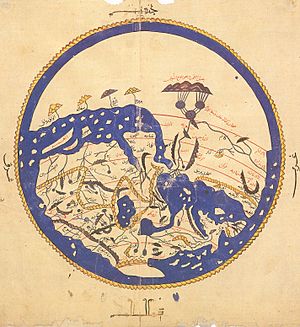
Besides translating old works, scholars at the House of Wisdom also did important original research. For example, the famous mathematician al-Khwarizmi worked there. He is known for his work in developing algebra. The word "algorithm" comes from his name.
Al-Kindi also worked at the House of Wisdom. He studied cryptanalysis (code-breaking) and was a great mathematician. He was the first to introduce Aristotle's philosophy to the Arab world. He mixed Aristotle's ideas with Islamic beliefs. This created a new platform for debates among thinkers.
Al-Jahiz, a biologist, wrote Book of Animals. He discussed how animals adapt to their environment. He even suggested that animals like dogs and wolves might have come from a common ancestor.
The Banū Mūsā (Sons of Moses) were three brothers who were engineers and mathematicians. They wrote the Book of Ingenious Devices, describing about 100 inventions. One was "The Instrument that Plays by Itself," an early programmable machine. They also made important contributions to astronomy and physics. Mohammad Musa might have been the first to suggest that the laws of physics are the same everywhere.
In medicine, Hunayn wrote an important book on eye care. Other scholars wrote about smallpox, infections, and surgery. These works later became standard medical textbooks in Europe.
Under al-Ma'mun, science saw its first large research projects with many scholars. To check Ptolemy's observations, the caliph ordered the first astronomical observatory in Baghdad. Geographers, mathematicians, and astronomers carefully checked and updated Ptolemy's data. Al-Ma'mun also organized research on the Earth's size. He ordered a map of the world, which was one of the most detailed of its time. Some see these efforts as the first examples of big government-funded research.
Astronomical Observatories
The first astronomical observatory in the Islamic world was built in Baghdad in 828. Caliph al-Ma'mun ordered it. Scholars from the House of Wisdom, like Yahya ibn abi Mansur, led its construction. It was called Maumtahan Observatory. After studying the Sun, Moon, and planets, a second observatory was built near Damascus. The results of this work were put into a book called al-Zij al-Mumtahan, or "The Verified Tables."
Famous Scholars
Here are some notable people connected to the House of Wisdom:
- Abu Ma'shar al-Balkhi (786–886)—a leading Persian astrologer who translated Aristotle's works.
- Avicenna (980–1037)—a Persian philosopher and doctor. He wrote The Canon of Medicine, a key medical text for centuries.
- Muhammad al-Idrisi (1099–1169)—an Arab geographer who helped create a famous world map.
- Muhammad ibn Musa al-Khwarizmi (died 850)—a Persian genius who led the House of Wisdom. He founded algebra, and the word "algorithm" comes from his name.
- Al-Kindi (died 873)—one of the first Arab philosophers. He combined ideas from Aristotle and Plato.
- Hunayn ibn Ishaq (809–873)—a Christian scholar and doctor who led the House of Wisdom's translation work. He translated over 116 important writings.
- The Banu Musa brothers—amazing Persian engineers and mathematicians.
- Thābit ibn Qurra (826–901)—a mathematician and astronomer who improved the Ptolemaic system. He is seen as the founder of statics (the study of forces).
- Al-Jahiz (781–861)—an author and biologist known for Kitāb al-Hayawān (Book of Animals).
- Ismail al-Jazari (1136–1206)—a physicist and engineer famous for his book The Book of Knowledge of Ingenious Mechanical Devices.
- Omar Khayyam (1048–1131)—a Persian poet, mathematician, and astronomer.
Other "Houses of Wisdom"
The House of Wisdom in Baghdad greatly influenced other libraries in the Islamic world. It connected many different people and empires through education and research. It became a model for many libraries that came after it. These new libraries wanted to copy the successful features of Baghdad's House of Wisdom.
Some other places have also been called "House of Wisdom":
- In Cairo, Dar al-Hikmah (House of Knowledge) was another name for the House of Wisdom. It was founded by the Fatimid Caliph, al-Hakim bi-Amr Allah in 1004. Its library was so huge it was called a "Wonder of the World."
- The Aghlabids House of Wisdom was founded in Raqqada by Amir Ibrahim Ibn Mohammad al-Aghlabī. Scholars traveled to Baghdad yearly to bring back important writings for this library.
- The Andalusian House of Wisdom was built in Andalusia by Caliph al-Hakam al-Mustansir. He was a master scholar and collected a vast number of books. This library was also based on the Baghdad House of Wisdom.
- Today, there is a research institute in Baghdad called Bayt Al-Hikma. It is named after the old center but is not the same building.
- Beït al-Hikma (House of Wisdom) was established in Tunis, Tunisia, in 1983.
- The main library at Hamdard University in Karachi, Pakistan, is called 'Bait al Hikmah'.
- La Maison de Sagesse (House of Wisdom) is an international organization based in France.
- The House of Wisdom دارالحکمة س was established in Tehran, Iran, in 2017.
- The House of Wisdom was established in Fez, Morocco, in 2018.
See also
- Round city of Baghdad
- Islamic Golden Age
- Mathematics in the medieval Islamic world
- Astronomy in the medieval Islamic world
- Geography and cartography in the medieval Islamic world
- Brethren of Purity


